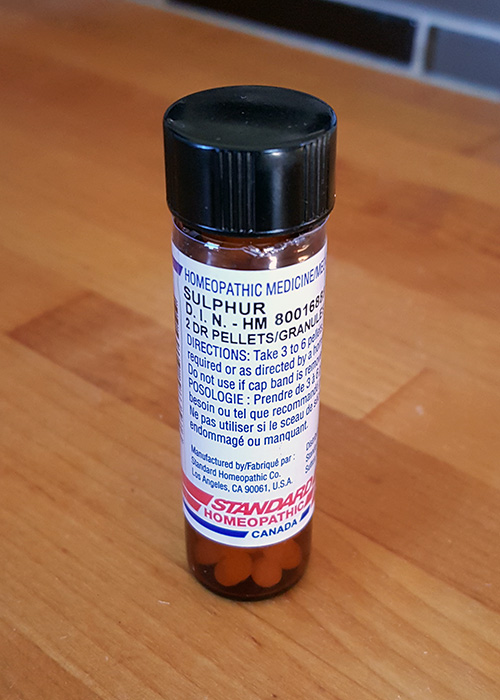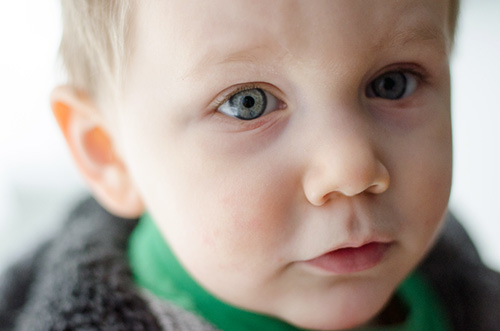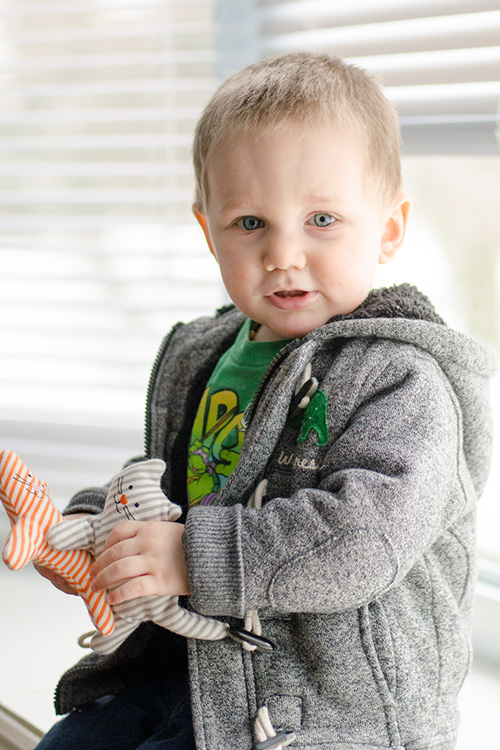[UPDATED December 16, 2020: Fixing links; recommending against using Johnson & Johnson baby shampoo and using Live Clean instead; fixing some words here and there because this post is quite a few years old now. Our kid is possibly starting to get another chalazion after years of having none, so we’ll see how this pans out.]
[UPDATED May 19, 2016: Have you been here before? I’ve added new stuff to this post. Scroll to the bottom for my favourite chalazion-busters yet.]
When our little guy got his first chalazions (one under each eye, ugh) around the age of one and a half, we naturally thought they were styes. I get them every so often from eye makeup, and figured that if they’re contagious, he may have gotten one from me that eventually spread by his rubbing his eyes. Eventually though, both ‘styes’ got so big that I started researching and learned about chalazions.
We visited several doctors who (as they don’t specialize in these things) weren’t quite sure how to help except to prescribe meds that unfortunately helped nothing.
When we finally got in with a pediatric opthalmologist (she’s in-demand and had a long waiting list) her suggestion was lots of warm baths, cleaning the eyes with baby shampoo a few times a day, and warm compresses.
Compresses would probably work wonders, in an ideal world where toddlers and babies don’t think you’re trying to murder them when you hold them in place with a damp rag over their eyeballs. I did not live in such a world, so I researched on, while we kept a strict routine of baby shampooing the poor kid’s eyes and failing to ‘compress’.
A chalazion (/kəˈleɪziən/; plural chalazia /kəˈleɪziə/), also known as a meibomian gland lipogranuloma, is a cyst in the eyelid that is caused by inflammation of a blocked meibomian gland, usually on the upper eyelid. Chalazia differ from styes (hordeola) in that they are subacute and usually painless nodules.
Painless as they are, they look painful as a mother. Perhaps worst of all, they take a long time to go away. It took months for the bumps to subside and he now has little scars where they were. (From the amount of cleaning, maybe.) [UPDATE: July 25, 2018] His scars have faded almost completely now! We’re probably the only ones who might notice the little dots of them under his one eye.
Below are the methods that seemed to help most, opthalmologist-advised and through my own research.
[IMPORTANT: Please do your own additional research and consult with your doctor if you’re unsure. I do not give exact dosages or distributions because every situation is different. These suggestions are based on our experience, not official medical research. I compiled them because it took a lot of time and frustration to find 3 things that finally seemed to help clear up his chalazions.]

Persistent cleaning with baby shampoo.
This was when a difference seemed to begin.
Do not be surprised if the chalazions become blood blisters, or actually secrete blood or pus. That is how they drain. The opthalmologist told us this would happen if we were cleaning right. :/ Thankfully we only saw it happen a couple of times because it looks pretty scary, especially on a kid.
Clean the eyes a lot, but be gentle. Baby shampoo (suggested by the opthalmologist) still stings a bit and scares a tiny kid.

We used to use Johnson’s Baby Shampoo for his eyes because we had a lot of it on hand (we used to receive many Johnson’s sample coupons in the mail). However, more recent events have made me wary of that brand. We love and recommend Live Clean because it’s environmentally friendly and I trust it to make other things too, like homemade baby wipes! I’ve linked to the Tearless Shampoo & Wash version which is a wonderful and safe multipurpose product. They make many delicious smelling shampoos for adults too, by the way.
We used cotton washcloths and eventually cotton swabs to apply the shampoo, using a different part of the cloth/swab for each eye. We used freshly wet parts of the cloth to rinse each eye clean. He is much better about it now that he’s older (yep, we still do it as part of our routine), but it was difficult for a while. We did it 3-4 times a day when the chalazions were large, and 2 times daily now.
Be as consistent as possible. As our doctor said, keeping it clean even after it clears up is important to prevent recurrence.
Sulphur.
I found a post on ABCHomeopathy.com which reflected our situation in almost every way. In desperation, we followed advice given there by a naturopath which had worked for the original poster. Coincidence or not, this was around the time our son’s chalazions shrunk most dramatically.
The original poster on that thread says they still keep Sulphur pellets handy years later to use whenever they see one of these cysts beginning on their child. (Note: Liquid and pellet varieties are available. We used 30C pellets and dissolved into filtered water, first thing in the morning as suggested.)

These are the ones we’re currently using (available at a local health food store) but Boiron Sulphur 30C pellets also worked. We use these as soon as we notice the typical constant eyes watering he gets before eye issues arise.
Also! Try incorporating sulphur-rich foods like onions, eggs and broccoli. More info here on which sulphur rich vegetables to use, how to cook them, and sulphur benefits in general. I found that when we let our diets (and, subsequently, his) slip for a few days, that’s when problems arose again.
Organic unrefined virgin coconut oil.
Oooh, buzzwords! Right? Eh. In this case, it seems to make a difference.

I love Nutiva’s quality for skin care, cooking, and (years ago) making homemade wipes.
After some trial and error, we used Nutiva Coconut Oil (smaller version than shown in my photo above). It’s available in many sizes but the bigger one lasts a good while.
If you try the run-of-the-mill coconut oil you get from your grocery store for $3.99 versus this stuff, even just for cooking, the difference in quality is noticeable. Nutiva’s consistency is infinitely better. The taste is much more delicious. It’s healthier and has an incredible number of applications.
More relevantly, it seemed to help our son’s chalazions shrink some, especially when compared with the results of the cheap stuff we had before.
[Again, I am not a doctor. If you’re allergic or reactive, don’t try it. Otherwise, it may give some relief, so read on.]
I read somewhere to try organic, unrefined coconut oil on the skin while the pores are still open to help soften a chalazion. They said to think of it in terms of oil dissolves oil. The hardened oil beneath the skin of the chalazion needs to soften in order to drain during cleaning/compress.
If you can’t use a warm compress for 10-15 minutes twice a day, apply the coconut oil immediately after cleaning with the baby shampoo and warm water. Coconut oil is anti-fungal and anti-inflammatory applied topically or ingested (see #2 here).
As you can imagine, it gets in the eyes a bit. It doesn’t sting though, and as far as I’ve read there are no ill effects of that happening other than the eyes blur a bit for a few seconds as they would with water in them. Do your own research on this to clarify, as I’m sure you will if you’ve landed on this page.
We started applying coconut oil after cleanings just before trying sulphur pellets and I think it did help to promote healing a bit as the chalazions gradually left. It seemed to help soften each one, even if it’s just in my imagination, and it didn’t bother him — bonus!
Other chalazion treatment suggestions I’ve seen from other people — I have no experience with any of these:
- Graphites
- Removing dairy from diet
- Massaging the chalazion to soften the oil in order to drain
(kid wouldn’t let us)Edit: He eventually let us! (And hated it.) It may have helped a bit.
I’m happy to say that they did eventually go away. After our final visit with the opthalmologist, she said that he was 95% improved and would not need another follow-up appointment, and she was correct. She said this will be a recurring problem and that regular twice or three times daily cleaning will be needed on an ongoing basis.


Taken a week before this post was originally written.
I know how frustrating and time consuming it is to take care of and try to prevent this unsightly, seemingly hopeless cyst, and I sincerely hope something here will work for you too.
For me, it helps to remember that consistent cleaning and immediate preventative measures at the first sign of a problem go a long way.
I’m so glad our little boy’s eyes improved with time. My favourite recommendation: Sulphur. It seemed to make the greatest improvement once we found out about it and got some, and also seemed to take down a bout of persistent styes he had a while later.
—
Update +1: Salt water!
It might sound as if it stings. And it does for a quick second, if you have styes. I tried this on myself first because it sounded sketchy. Each time, my stye felt better soon after and was gone the next day. If it stung my son’s chalazions, he did not let on. He just got annoyed with all the eye stuff in general and ran the other way.
- Add half teaspoon to a teaspoon of salt in a small amount of very warm (not hot) filtered water. I currently use Mediterranean but have also used iodized and epsom salts with good results. Keep in mind epsom salts are not actually made of the same stuff as the salt you would consume, but both seem to help.
- Stir to dissolve all salt.
- Dip cotton ball in the solution, squeeze cotton ball so it’s not dripping.
- Apply lightly to the affected eye, running it gently over the chalazion. You only need to do this for about 30 seconds to a minute.
- Do not rinse, OR #6
- Do a warm compress after if you want to try and draw more of the pus out, then follow the cleaning routine above.
I’m so grateful to have read about this salt method. I don’t know if it works every time. The bigger sulphur pellets we had bought most recently at a health food store weren’t working as quickly with the latest chalazion he’d had for a month and a half. We began this doing treatment once or twice daily. The pus was almost always brought to the surface, sometimes the cyst even opened up on the spot — at which point I’d always do the gentle warm compress for as long as he’d let me, then clean and apply coconut oil.
It took a few times draining it over the course of about a week but each day we noticed improvement.
Update +2: Organic flax oil!
We buy this at our local drugstore for about $8/400mL bottle but health food stores will have it too.
Mix a teaspoon into the child’s diet daily, chalazion or not. Since we’ve incorporated this, not only has his chalazion been less inflamed, but his skin issues have improved wonderfully. (I had baby pimples and he seems to have inherited them.) I’m really not sure of the reason, but the person I read this from suggested it’s similar to the coconut oil method above. I find flax oil has made an improvement much faster than coconut oil though, probably due to consuming it rather than using it topically.
—
Yeesh, I’ve said a lot here. I really hope it helps if you’re scouring the world for a solution though.
Have you had a chalazion? What have you found to be your most effective treatment? Leave a comment below!






Nikki, I am glad that I found so much information on a child’s chalazion here. In our case, the chalazion is red all the time, and the skin is peeling on it. Is it normal? How was it for you?
Hi Paula. His were very often red and sometimes peeling. I think this had a lot to do with the frequent cleaning, but they were red and inflamed before we got a proper diagnosis too. I think it may just come with the territory.
Hello, with the salt method, approximately how much warm water is a small amount? I’m ready to try this tonight! Thank you..
Hi Josie. I don’t have an exact amount, sorry! I just would make sure it’s diluted and mixed pretty well. Good luck!
Hi. I have a chalazion on my top lid right now and it’s awful. I had no idea these were a thing and I’m so sorry for anyone going through it! Wanted to share that I am trying ALL the things and I do think it has come down some + is less red, so thank you for all of these great home remedies. Prior to funding your blog, my eye dr didn’t make me feel very good when I went in for a follow up and gave me a referral to an eye plastic surgeon. I am working so hard now to avoid that. I also wanted to share something new I hadn’t read anywhere else before, that I stumbled upon today—IPL laser treatment is a non-invasive option to have them removed! I am going for a consult tomorrow. They told me there was a girl with a chalazion so bad she couldn’t open her eye, and after just three IPL treatments, it was nearly gone. The place had so much info it was amazing to find, and at the right time! I am so grateful for it. Wanted to share this for anyone as desperate as I to have this darn thing gone, but really really dreading and avoiding surgery as much as possible.
Hi Bridgette.
I’m sorry to hear you’re going through this. It’s such a struggle.
Thank you so much for sharing about IPL laser! I hope it helps you. Please keep us posted if you end up getting it done.